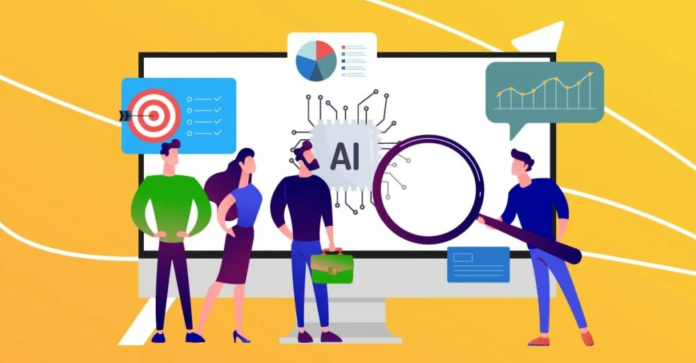In the rapidly advancing landscape of technology, Artificial Intelligence (AI) stands as a transformative force with profound implications across numerous sectors. AI, in essence, refers to the development of computer systems capable of performing tasks that typically require human intelligence, such as learning, reasoning, problem-solving, and decision-making.
Its importance in today’s world cannot be overstated. AI has become the backbone of innovation, driving groundbreaking advancements in healthcare, finance, marketing, and more. It powers everything from virtual assistants like Siri and Alexa to complex algorithms that can predict stock market trends or aid in diagnosing medical conditions.
AI’s significance lies not only in its ability to automate repetitive tasks but also in its capacity to analyze vast amounts of data, uncover patterns, and make predictions with remarkable accuracy. This empowers businesses to make data-driven decisions, enhances customer experiences, and contributes to the development of autonomous systems.
In essence, AI has become an indispensable tool for organizations and individuals alike, revolutionizing industries, improving efficiency, and shaping the way we interact with technology in our daily lives. As AI continues to evolve, its impact on society is only expected to grow, making it an exciting and essential field to explore and understand.
List of 10 Best AI Tools for Streamlining Your Business Operations
Certainly! Here’s an expanded list of 10 top AI tools that can help streamline various aspects of your business operations:
- IBM Watson
- Category: AI-Powered Analytics and Machine Learning
- Key Features: Offers AI-powered tools for data analysis, natural language processing, image recognition, and predictive analytics. Used in industries such as healthcare, finance, and customer service.
- UiPath
- Category: Robotic Process Automation (RPA)
- Key Features: Automates rule-based, repetitive tasks by mimicking human actions within software applications, enhancing efficiency and reducing errors.
- Chatfuel
- Category: Chatbot Development
- Key Features: Allows the creation of chatbots for platforms like Facebook Messenger to automate customer support, answer FAQs, and engage with customers 24/7.
- Salesforce Einstein
- Category: AI-Powered CRM
- Key Features: Enhances customer relationship management by using AI to analyze data, predict trends, and provide personalized recommendations.
- Google Cloud AI
- Category: AI Services and APIs
- Key Features: Provides AI services like Vision AI, Natural Language AI, and Translation AI, enabling integration into applications for image analysis, text understanding, and language translation.
- Microsoft Azure AI
- Category: AI Services and Tools
- Key Features: Offers a suite of AI tools and services, including Azure Machine Learning, Azure Cognitive Services, and Azure Bot Service, for various AI applications.
- Amazon Web Services (AWS) AI Services
- Category: AI-Powered Services
- Key Features: Provides a range of AI services, such as Amazon Lex for chatbots, Amazon Rekognition for image analysis, and Amazon Comprehend for natural language processing.
- SAP Leonardo
- Category: AI for Enterprise
- Key Features: Integrates AI into business processes, offering capabilities for IoT, machine learning, and analytics to drive digital transformation.
- HubSpot
- Category: Marketing Automation with AI
- Key Features: Uses AI for lead scoring, email marketing, and content optimization, helping businesses improve their marketing strategies and customer engagement.
- Trello Butler
- Category: Project Management and Automation
- Key Features: An AI-powered automation tool within Trello, it automates repetitive tasks and workflows, streamlining project management and collaboration.
These best AI tools cater to various aspects of business operations, from automating tasks and improving customer interactions to enhancing data analysis and decision-making. When choosing the right AI tools for your business, consider your specific needs, industry, and integration requirements for the best fit.
What is Data Analysis?
Data analysis is the process of inspecting, cleaning, transforming, and interpreting data to discover useful information, draw conclusions, and support decision-making. It involves using various techniques and tools to extract meaningful insights from raw data, helping businesses, researchers, and individuals make informed choices and solve problems.
Here are the key steps involved in data analysis:
- Data Collection: The process begins with gathering relevant data from various sources, which can include surveys, sensors, databases, websites, and more.
- Data Cleaning: Raw data often contains errors, missing values, or inconsistencies. Data cleaning involves identifying and rectifying these issues to ensure the accuracy and reliability of the data.
- Data Transformation: Data may need to be transformed or reshaped to make it suitable for analysis. This can involve aggregating data, encoding categorical variables, or normalizing numeric values.
- Data Exploration: Exploratory data analysis (EDA) involves visually and statistically exploring the data to understand its characteristics, such as distribution, patterns, and outliers. Visualization tools like charts and graphs are commonly used.
- Data Analysis Techniques: Depending on the objectives, various data analysis techniques are applied, including:
- Descriptive Statistics: Summarizing and describing data using measures like mean, median, and standard deviation.
- Inferential Statistics: Making predictions or drawing conclusions about a population based on a sample.
- Regression Analysis: Identifying relationships between variables.
- Hypothesis Testing: Testing whether observed differences or relationships are statistically significant.
- Machine Learning: Using algorithms to make predictions or classify data.
- Time Series Analysis: Analyzing data points collected over time to identify trends and patterns.
- Data Interpretation: The insights gained from data analysis are interpreted to extract actionable information and draw conclusions.
- Visualization: The results of data analysis are often visualized to make them more accessible and understandable to stakeholders. Data visualization tools help in creating charts, graphs, and interactive dashboards.
- Reporting: Findings and insights are typically documented in reports or presentations, which are shared with relevant stakeholders to support decision-making.
Data analysis is a crucial process in various fields, including business, healthcare, finance, research, and more. It helps organizations identify trends, discover opportunities, mitigate risks, and optimize processes. With the advent of advanced technologies like artificial intelligence and machine learning, data analysis has become even more powerful and capable of handling large, complex datasets for predictive and prescriptive analytics.
List of 10 Best AI Tools for Data Analysis: Making Sense of Big Data
Here’s a list of 10 best AI tools for data analysis that can help businesses and professionals derive insights from their data:
- Tableau
- Key Features: Tableau combines data visualization with AI-driven analytics, making it easier to explore, understand, and present data insights. It offers features for data blending, forecasting, and natural language processing.
- Microsoft Power BI
- Key Features: Power BI is a business analytics tool that provides AI-driven features for data visualization, automated insights, and the ability to embed AI and machine learning models into reports.
- Google Data Studio
- Key Features: Google Data Studio allows users to create interactive and customizable data dashboards. It can be integrated with various data sources and can leverage Google’s AI capabilities for insights.
- KNIME
- Key Features: KNIME is an open-source platform for data analytics, reporting, and integration. It offers a wide range of AI and machine learning extensions for data processing and modeling.
- RapidMiner
- Key Features: RapidMiner is an integrated data science platform that provides AI-driven features for data prep, machine learning, and model deployment. It’s known for its user-friendly visual interface.
- Alteryx
- Key Features: Alteryx is a self-service data analytics platform that uses AI and machine learning to automate data cleansing, blending, and predictive modeling.
- DataRobot
- Key Features: DataRobot is an automated machine learning platform that helps users build, deploy, and manage machine learning models without requiring extensive coding or data science expertise.
- IBM SPSS
- Key Features: SPSS is a statistical software that integrates AI for predictive analytics, data mining, and advanced statistical analysis. It’s widely used in research and business analytics.
- SAS Enterprise Miner
- Key Features: SAS Enterprise Miner is a data mining and machine learning tool that assists in creating predictive models and conducting advanced analytics using AI techniques.
- Orange
- Key Features: Orange is an open-source data visualization and analysis tool that incorporates AI and machine learning for data exploration, visualization, and predictive modeling.
These AI-powered data analysis tools offer a range of capabilities, from data visualization and automated insights to advanced predictive modeling and machine learning. Choose the tool that aligns with your specific data analysis needs and preferences.



